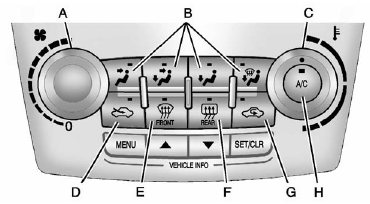Climate Control Systems
The vehicle's heating, cooling, defrosting, and ventilation can be controlled with this system.

A. Fan Control
B. Air Delivery Mode Controls
C. Temperature Control
D. Outside Air
E. Front Defrost
F. Rear Window Defogger
G. Recirculation
H. Air Conditioning
 (Fan Control): Turn to increase
or decrease the fan speed. Turn the knob completely to T to turn the fan off.
(Fan Control): Turn to increase
or decrease the fan speed. Turn the knob completely to T to turn the fan off.
Temperature Control: Turn to increase or decrease the temperature.
Air Delivery Mode Control: To change the current mode, select one of the following:
 (Vent): Air is directed to the instrument
panel outlets.
(Vent): Air is directed to the instrument
panel outlets.
 (Bi-Level): Air is directed to the
instrument panel outlets and the floor outlets.
(Bi-Level): Air is directed to the
instrument panel outlets and the floor outlets.
 (Floor): Air is directed to the
floor outlets.
(Floor): Air is directed to the
floor outlets.
 (Defog): Clears the windows of fog
or moisture. Air is directed to the windshield and floor outlets.
(Defog): Clears the windows of fog
or moisture. Air is directed to the windshield and floor outlets.
 FRONT (Front Defrost): Clears the
windshield of fog or frost more quickly. Air is directed to the windshield and side
window outlets.
FRONT (Front Defrost): Clears the
windshield of fog or frost more quickly. Air is directed to the windshield and side
window outlets.
For best results, clear all snow and ice from the windshield before defrosting.
Do not drive the vehicle until all the windows are clear.
See also:
Sheet Metal Damage
If the vehicle is damaged and requires sheet metal repair or replacement, make
sure the body repair shop applies anti-corrosion material to parts repaired or replaced
to restore corrosion protecti ...
Radio
To select preset or favorite radio stations:
Press and release or
to go to the next or previous radio station stored as a preset or favorite. ...
Instrument Panel Illumination Control
(Instrument Panel Brightness): This feature controls the brightness of the instrument panel lights and is located next to the exterior lamps control.
Push the knob to extend out and then it can be ...





